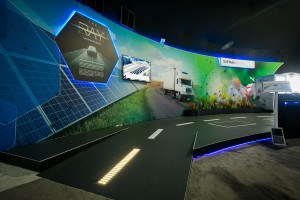The Ray trials smart technology on Georgia’s I-85
First published at CONEXPO-CON/AGG - March 11, 2020
Over the past three years, more than ten new smart technologies have been installed on an 18-mile stretch of Interstate 85 in Georgia. This is The Ray, infrastructure’s first public-private-philanthropic-partnership (P4) which aims to improve sustainability, safety and the environment for roads and transportation.
“Trying new things is hard, particularly on highways and interstates, because of the risks involved. My job is to mitigate those risks,” said Allie Kelly, executive director of The Ray, whose partners include the US’s Federal Highways Administration, the Georgia Department of Transportation, the Ray C. Anderson Foundation, research organisations and private sector companies. “Any of these technologies that perform and succeed here, we aim to scale to other parts of the country and other parts of the world.”
Technology under trial includes Connected Road Striping developed by 3M which uses amber and white glass elements to create road markings which are visible to autonomous vehicles; solar roadways from Hannah Solar and Wattway; and dynamic tyre checking from WheelRight.
Panasonic is working with The Ray to build a digital platform for managing connected vehicle data. As well as analysing a host of connected vehicle data to prevent accidents and incidents, this will also be the key to pay-per-use road charging, says Kelly.
“This means we can have people contribute to transportation maintenance based on how much they use the road system,” said Kelly. “Right now, our state DoTs [departments of transport] are reliant on gas tax. As we have more electric vehicles, funding from gas tax will fall.”
The Ray is trialling other potential new sustainable revenue streams too. It has just finished installing 2,600 solar panels on land by the interstate which is owned by Georgia DoT. Deals with energy companies could include charging land rents, negotiating favourable energy deals and gaining some of the valuable renewable energy credits gained from solar energy production. Roadside energy generation could also allow coils to be installed in the road so that electric vehicles can be dynamically charged, said Kelly.
Tech Experience tent (Silver Lot 3)
Companies in this article
The Ray
Most popular news
- Software collaboration tool from Bentley
March 13, 2020 - VSS Macropaver adds telematics to its complete line-up of machines
March 13, 2020 - LiuGong unveils new mini excavator trio
March 13, 2020 - Kleemann showcases mobile crushers and screeners
March 13, 2020 - Brokk unveils Atomized Water Mist system for silica dust suppression
March 13, 2020 - OilQuick and Engcon join forces on new tiltrotator
March 13, 2020












